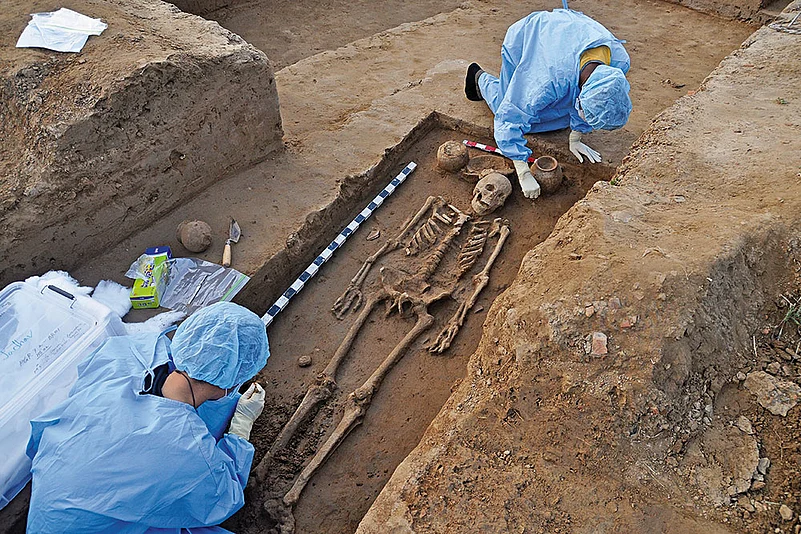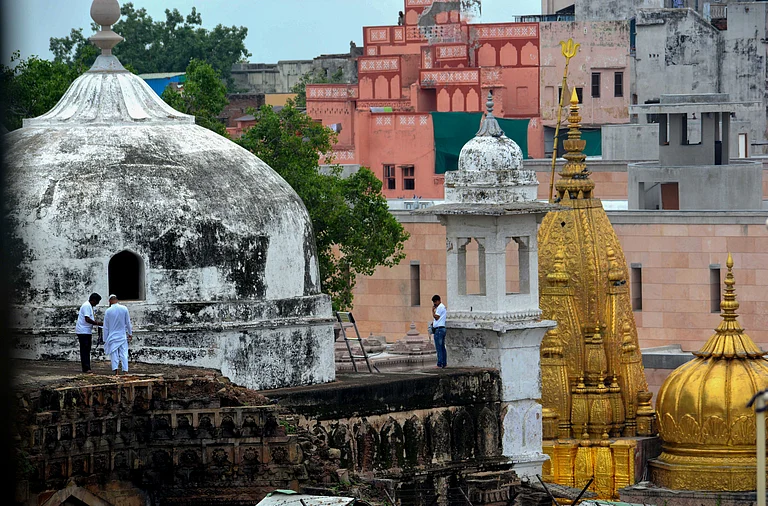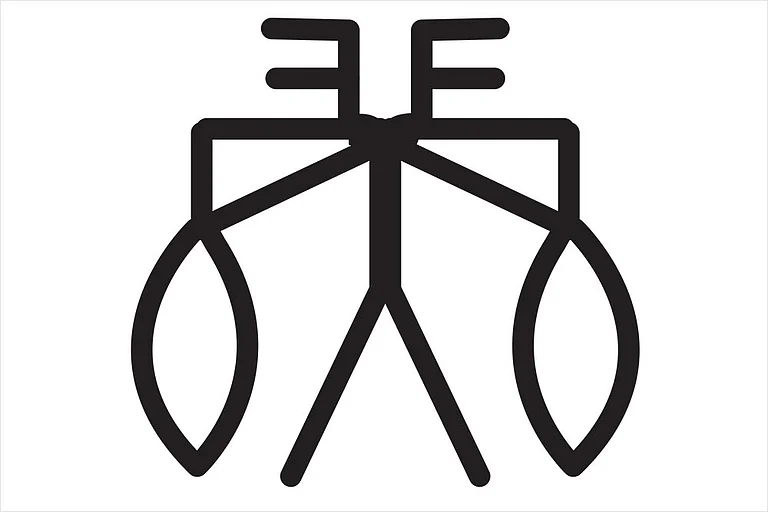In the chilly Delhi winter of 2008, scholars of Indic ideology gathered in the hallowed halls of the India International Centre for a major conference on the origins of the Saraswati River. This mystical and mythical river, along with the Ganga and Yamuna, forms the holy trinity considered to be the cosmic core of Hindu civilisation.
Unlike the Ganga and Yamuna, which flow through numerous streams and tributaries in northern India, the Saraswati has vanished, leaving little trace of its origins. However, its existence is central to the belief of Hindu nationalists that Vedic culture is deeply rooted in the advanced Indus Valley Civilisation (IVC), which is said to have thrived for millennia along the banks of the Saraswati River.
At the two-day conference, scholars from disciplines such as archaeology, geology, history, seismology and life sciences presented papers building on discoveries made over the last century. These findings, they claimed, proved beyond doubt that Hindu civilisation was ancient, indigenous to the subcontinent and emerged along the banks of the Saraswati River.
The conference put forth a hypothesis that the ancient IVC developed on the banks of the Saraswati, not the Indus River. It suggested that this group of people gave birth to Vedic culture, which appears to be the precursor to the existing Hindu civilisation. Most significantly, it sought to debunk the widely accepted Aryan Invasion Theory, calling it imaginary and negating the idea of any large-scale migration of peoples into India. The Aryan Invasion Theory, propounded in the 1940s by British archaeologist William Mortimer Wheeler, posits that a group of Indo-European-speaking nomadic peoples from the Central Asian steppes, known as the Aryans, migrated to the Indian subcontinent around 1200 BCE, invading or replacing the IVC.
S. Kalyanraman, a prominent Indic scholar, was convinced that the papers and scholarly discussions at the conference dispelled lingering doubts, affirming that the Saraswati was not merely a mythological river. He hoped the new research would persuade proponents of the “Aryan Invasion” colonial myth to reconsider their stance.
However, without irrefutable archaeological and scientific evidence regarding the dating sequence of the IVC and Vedic periods, the hypothesis failed to gain significant news traction. The IVC is believed to have started declining around 1900 BCE, gradually being replaced by the Aryan people. The Aryans are thought to have introduced domesticated horses, the Sanskrit language and new customs of worship and culture, establishing the Vedic civilisation. The oldest record of the Vedic period, the Rig Veda, is dated to around 1500 BCE. This leaves a gap of 700 years between the end of the Harappan era and the arrival of the Aryans.
Cut to 2019, at the start of Hindu nationalist Prime Minister Narendra Modi라이브 바카라 second term, two research papers published in the prestigious scientific journals Cell and Science on the genetic origins of the people living in the Indus Valley during the IVC caused a media sensation and sparked feverish excitement. Mainstream news outlets reported that their findings rejected the Aryan migration theory. The new research, in essence, revisited the controversial claims surrounding the existence of the Saraswati civilisation.
The Science paper, co-authored by 117 scholars, analysed genome-wide data from 523 individuals across Central Asia and northernmost South Asia. It revealed that the primary source of ancestry in modern South Asians is a prehistoric genetic gradient between early hunter-gatherers of Iran and Southeast Asia. The research published in Cell, authored by 28 scholars, analysed DNA from skeletal remains at Rakhigarhi, Haryana—one of the largest IVC sites. It supported the Science paper라이브 바카라 findings, showing that the Harappan people “did not have ancestry from Steppe pastoralists or Anatolian and Iranian farmers,” suggesting farming in South Asia arose from local foragers rather than large-scale migrations from the West.
Both papers established that Steppe ancestry arrived after 2000 BCE and mixed with other groups to form the present-day ancestry of modern Indian populations.
A 2009 study by scientists from the Centre for Cellular and Molecular Biology (CCMB), Hyderabad, Harvard and MIT also supported the large-scale migration theory. It found that nearly all Indian groups descend from a mix of Ancestral North Indians (ANI), related to western Eurasians and Ancestral South Indians (ASI), derived from Southern Asia라이브 바카라 hunter-gatherer populations.
The absence of Steppe genetics in the IVC period before 2000 BCE, archaeologist Vasant Shinde, lead author of the Cell paper, claimed, showed that Harappa had “an indigenous population, untouched by outside migration, which shows continuity till modern times.” Shinde suggested that the Harappan period was synonymous with the Vedic period, citing archaeological, genetic and cultural evidence.
“Harappans and Vedic people were the same,” Shinde says. “This is because Harappan remains are found in the Sapta Sindhu region inhabited by Vedic people and references to the Saraswati river further support this. Present-day traditions, culture and crafts in Rakhigarhi strongly resemble Harappan culture.”
A contentious issue, however, remains the origins of Sanskrit, an Indo-European language believed to have been introduced by the Steppe pastoralists. Shinde suggested Sanskrit might have been developed locally and spread to the Steppe regions through outward migration from the IVC. “This hypothesis needs further research, but we’re finding indications,” he added.
Shinde라이브 바카라 emphasis on Harappan indigeneity and his interpretation of DNA research challenging the Aryan migration theory, sparked criticism from historians, archaeologists and academics who accused him of advancing a politically motivated Hindutva narrative.
Several historians noted that the Cell and Science papers state that the Steppe pastoralist ancestary is widespread among Indian populations. These findings are corroborated by the Aryan migration theory which posits that the Steppe pastoralists arrived from the central Asian Steppe after the decline of the Harappan Civilisation.
Critics also pointed to contradictions between the Vedic and Harappan eras. The Rig Veda, for instance, mentions horses (asva) over 170 times, yet skeletal remains of horses are absent in the Harappan archaeological record. Similarly, the Rig Veda describes pastoral settlements, while the IVC was marked by advanced urban centres like Harappa and Mohenjodaro, which housed populations of up to 80,000 with highly organised civic infrastructure.
Astronomer Mayank Vahia emphasised that “Vedic evidence is entirely literary, whereas Harappan evidence is entirely archaeological. Reconciling these two periods is impossible,” he said.
Genetic and astronomical data continue to support the idea that Vedic people migrated from Central Asia, Vahia added. Bal Gangadhar Tilak라이브 바카라 Orion: The Antiquity of the Vedas (1893) and The Arctic Home in the Vedas (1903) theorised that Rigvedic people originated in far northern Central Asia, based on descriptions of prolonged sunlight absence, suggesting habitation near the Arctic Circle, which a lot of new data suggests could be a likely possibility.
In post-independent India, these theories were dismissed by M.S. Golwalkar, the second Rashtriya Swayamsevak Sangh (RSS) chief, who asserted that Aryans were indigenous to Hindustan. Golwalkar urged rewriting history to counter “misconceptions” and “distortions.”
Shinde said his DNA research was inspired by a desire to refute foreign scholars’ theories, proving that the Harappans were indigenous people responsible for agriculture and urbanisation in South Asia. “This culture evolved and transformed but continues to this day,” he said.
The Cell paper라이브 바카라 interpretation gained traction among Hindu revisionists, who view DNA analysis as a crucial piece of the puzzle in affirming the homeland of native Hindus. The BJP-led central government has endorsed the notion that Harappans were indigenous, rejecting Aryan migration. Ideologically the BJP and its parent organisation RSS share the indelible belief that Hindu라이브 바카라 have lived in the sub-continent for thousands of years before they were invaded by marauding foreign invaders. It further strengthens the core belief that India is a country of Hindus, while Muslims and Christians are foreigners.
In this vein, the Union Ministry of Culture established a 16-member committee, led by veteran Vedic scholar KN Dixit, to study Indian culture라이브 바카라 evolution over 12,000 years. Findings from this study will be incorporated into school textbooks in place of previous cultural interpretations.
The National Council of Educational Research and Training (NCERT) has already proposed including the Rakhigarhi DNA findings in the Class 12 history syllabus.
“Our scholars have demonstrated through DNA analysis that Aryans were native to India,” says Balmukund Pandey, head of the RSS라이브 바카라 Akhil Bharatiya Itihas Sankalan Yojana. “The Aryan invasion theory was a colonial falsehood meant to divide Indians. We must now foster a sense of pride in our indigenous history.”
The RSS라이브 바카라 history wing, supported by 5,000 historians, plans to rewrite history books and promote projects like the Indian Council of Historical Research라이브 바카라 Comprehensive History of Bharat with revisions based on DNA analysis.
“Our objective is to make Indians feel proud of their history. Foreigners came here and distorted our history to colonise us. This will not happen again as we are a free country and our historians have freedom,” Pandey concluded.
(This came as 'Fatherland, Holyland, Motherland' in print)


















